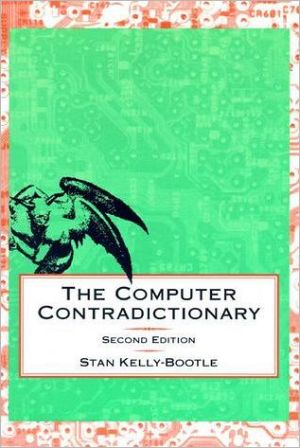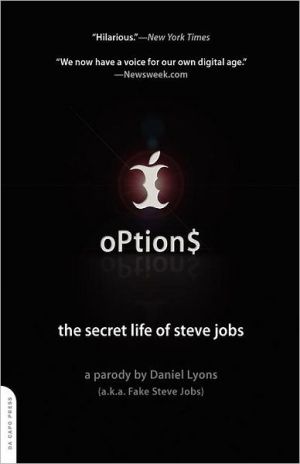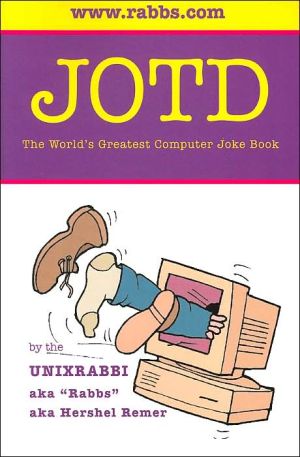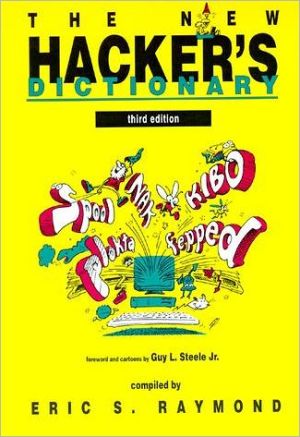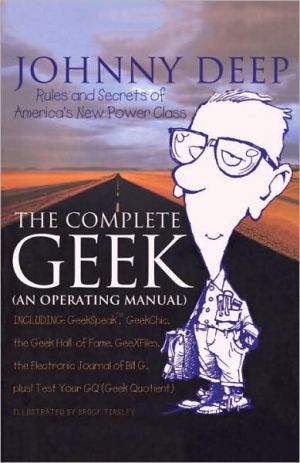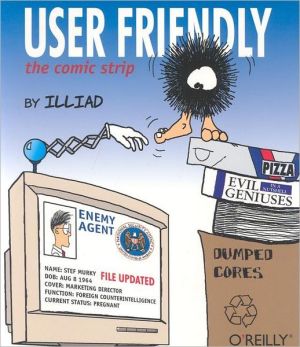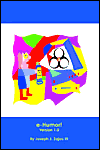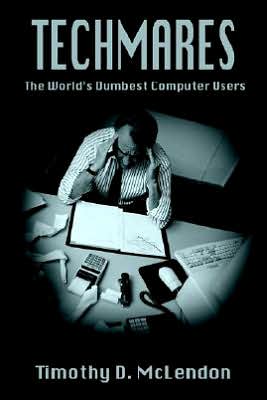The Computer Contradictionary
"Ascertain the meaning before consulting this dictionary," warns the author of this collection of deliberately satirical misdefinitions.\ New computer cultures and their jargons have burgeoned since this book's progenitor, The Devil's DP Dictionary, was published in 1981. This updated version of Stan Kelly-Bootle's romp through the data processing "laxicon" is a response to the "Unix pandemic" that has swept academia and government, to the endlessly hyped panaceas offered to the MIS, and to...
Search in google:
"Ascertain the meaning before consulting this dictionary," warns the author of this collection of deliberately satirical misdefinitions.New computer cultures and their jargons have burgeoned since this book's progenitor, The Devil's DP Dictionary, was published in 1981. This updated version of Stan Kelly-Bootle's romp through the data processing "laxicon" is a response to the "Unix pandemic" that has swept academia and government, to the endlessly hyped panaceas offered to the MIS, and to the PC explosion that has brought computer terminology to a "hugely bewildered, lay audience."The original dictionary, an urbane and witty pastiche of Ambrose Bierce's famous work, parried chiefly the mainframe and mini-folklore of the 1950s, 1960s, and 1970s. This long-awaited revision adds over 550 new entries and enhances many of the original definitions. Key targets are "a host of new follies crying out for cynical lexicography [including] the GUI-Phooey iconoclasts, object orienteering, and the piping of BLObs down the Clinton-Gore InfoPike."ack n. [Origin: back-formed negation of nak.] A signal indicating that the error-detection circuits have failed.computer science n. [Origin: possibly Prof. P. B. Fellgett's rhetorical question, "Is computer science?"] A study akin to numerology and astrology, but lacking the precision of the former and the success of the latter.multimedia n. An application attacking all five senses of the user—sight, hearing, smell, taste, and touch—but especially, smell. Ray Duncan The Court Jester of Computerdom At ERCB, we try to focus attention on unique books, books of lasting value, books with class, books that break the mold, books with an air of distinction, books that that go boldly where no books have gone before -- in short, books with a certain individuality and The Computer Contradictionary, Second Edition, previously published ca. 1981 as The Devil's DP Dictionary, meets all these criteria and then some. Here we have a book that is so far off the beaten path that you will need a compass and a divining rod to find it and then return unmarked. The Computer Contradictionary was inspired by Ambrose Bierce's Devil's Dictionary, published in 1911. Bierce, a well-known cynic of his era, defined the dictionary as "a malevolent device for cramping the growth of a language and making it hard and inelastic." The author of The Computer Contradictionary, Stan Kelly-Bootle, is known by the younger set mainly for his Turbo C books, witty columns in UNIX Review, and sometime essays in Computer Language. But his polylingual, mordant, frighteningly literate, and often truly bizarre tall tales, word-plays, and puns have been a feature of the computer landscape for time out of mind. A few paragraphs from the Acknowledgments for the Second Edition will give you a taste of Kelly-Bootle's style (?) and typical dense web of allusions (or delusions): A nonlinear salute goes to Barry Richman, Mr. B. R., onlie begetter of the 1981 McGrUr-Hill text. He it was who pushed the DDPD [Devil's DP Dictionary] and breeched my baby. Si parientinas requiris, circumspice! But never look back. A transcendent appreciation is demanded for those who were acknowledged in, but have died since, the original DDPD. I see no direct cause-effect here, but a sad guilt pervades: "Y'a des petit's fleurs, y'a des copains au, au bois de mon coeur..." (Georges Brassens). For example, did Peter Davies, who guided me through the maze of roper lexicographical usages, and (O Schmerz!) caught my typo logomarchy (shades of malarkey?), ever know how much his loving help would be missed. Likewise, UCB-UNIX pioneer Jim Joyce (no relation except in Celtic exuberance), a rare bigraduate in Anglo-Saxon and Computer Science, is no longer here to home my vi skills or guzzle my Laphroig. I must also thank the custodians of the Ambrose Bierce House in St. Helena, California, where I browsed for bitter imbuement, including two nights spent in Lillie Langtry's bed (she was elsewhere, alas). Elsewhere in the Acknowledgments, Kelly-Bootle gives thanks and/or points the finger of blame at over a hundred real or imagined helper-bees, ranging from luminaries like Donald Knuth and Bertrand Meyer to hacker celebrities such as Richard M. Stallman and Guy Steele to more mysterious personages: The Dean of Westminster, la famille Sitter, the Baltimore Consort, the Liverpool Football Club, and a host of others with romantic and mysterious names or titles. Even the lowly Acknowledgments serve to demonstrate how just a few pages of Kelly-Bootle's prose can readily provide grist for several hours of puzzlement and bemusement. The Computer Contradictionary is organized alphabetically and lexicographically much like any dictionary, with the proviso that the first page warns the reader that "the meaning of an entry should always be ascertained before consulting this dictionary." The individual entries range from a few words to mini-treatises where Kelly-Bootle's imagination can and does run rampant. The original edition of the book was relatively mainframe-centric; the second addition, with some 500 additional definitions, has benefited (or suffered) from a sizable infusion of personal computing lore. A semi-random sampling follows: algorithm n. [Origin: ALGORISM with a pronounced LISP] A rare species endangered by the industry's cavalier pursuit and gauche attempts at domestication. ==> The current plight of the unspotted algorithm, Algorithmus accuratus, can be traced back to overculling in the 1960s. It will be recalled that the previous decade had witnessed an uncontrolled population growth, indeed a plague of the creatures in diverse academic terrains. Their pernicious invasion of the commercial environment in the late 1950s prompted IBM to offer the controversial $4.98 bounty per pelt. Hordes of greedy and unskilled people from all walks of life deserted their jobs and families, sold their possessions, and flocked to dubious, fly-by-night programming schools. Overarmed with high-level weapons, these roaming bands of bounty seekers hunted down and massacred the poor algorithm around the clock. The inevitable reaction occurred, but almost too late, in the form of an ecological "Save the Algorithm" lobby, replete with badges, bumper stickers, and fund-raising algorithms. Public opinion was aroused, in particular, by the future vice-president's catchy campaign song: Al Gore-ithm, Al Gore-ithm, Al Gore-ithm, Who could ask for anything more? The 1970s have brought some hope to the preservationists. Two reasonably hardy variants appear to have evolved, the Algorithmus pascalia and the Algorithmus heuristicus, which in their different ways are proving more resistant to the grosser exploitations of the unstructured. The new strains are partly the result of neo-Darwinian survival (the filter code overcomes an antagonistic environment) and partly the outgrowth of patient, prolonged interbreeding in areas protected by bagbiters, chompers, diddlers, users, and other anathematic influences. Wirth and Knuth deserve praise in this context. The hybrid A. seminumericalis, for example, gently nurtured by Prof. Donald Knuth, can be spotted regularly cavorting on the sylvan campi of Stanford University, California. Its sweet, anthropomorphically cuddlesome disposition attracts weekend crowds of panda proportions. The feeding signs state quite clearly that the hybrid will not perform for peanuts; indeed, the A. seminumericalis needs a substantial bunch of greenery before it will embark on its dazzling repertoire of parlor tricks, delighting all age groups and both cultures. Perhaps not all, for some killjoys liken these displays of mock intelligence to the exploitation of circus animals or the chimpanzee tea party. Also, there remains the fear that, however amusing and superficially sycophantic we breed our algorithmic pets, they will prove to be feline, superior, inscrutable, and the ultimate victor. binding time n. The moment when the hash table becomes corrupted. ==> Advances in computing can be mapped against the "lateness of binding," which has me thinking about my own so-called CS so-called career: golden past, gray present, and rosy future. This is my version of Synge's optimism: the grass is greener except at t=0. On EDSAC I, my functions (5ch paper-tape subroutines) were punched, spliced, and bound about two weeks before input. This is known as premature binding and calls for deftness with elastic bands. FORTRAN came next with a new kind of binding: soggy decks of cards that refused to be shuffled. Then with Algol and C, I enjoyed static (compile-time) binding, until C++ brought the numbing joys of dynamic (run-time) binding. My current research aims at delaying the binding until well after execution. I call this end-time binding, as prophesied in St. Matthew's Gospel: "...and whatsoever thou shalt bind on earth shall be bound in heaven..." (Matthew 16:19 KJV). diagnostic n. A person who doubts the existence of two gods. downtime n. The period during which a system is error-free and immune from user input. Compare UPTIME. See also CRASH. garbage n. & adj. \\pronounced gar-bidge but often pseudo-refined to gar-barge. cf. garage, barrage, cleavage.\\ 1 n. Rubbish, trash; the definining by-products of an effluent society. 2 n. User-perpetrated input. 3 n. (RAM) Essential, well-tried data unjustly denigrated by programs unable to gain access. 4 adj. (Of a collection) relating to frantic, futile, low-level attempts to avoid insufficient-memory errors by incurring insufficient-time errors. See also GIGO. lebensRAM n. The GUI conspiracy presaged in Adolf Hitler's Mein Kampf: "4 MB is my final demand." low-self-esteem books n. Also called books for the baffled. Any book riding on the huge success of DOS for Dummies (Dan Gookin, IDG Books, San Mateo, California). ==> My contest for rival titles (UNIX Review, October 1993) invoked: Visual BASIC for the Blind; Pacsal for the Dyxlesic; REXX for Ex-Monarchs; C++ for the Nonplussed; dBASE for the Debased; Quicken for the Dead; 1-2-3 for the Innumerate; CLU for the Clueless; and LISP for the Listless. In spite of this ridicule, the genre has grown to include The Complete Idiot's Guide to Brain Surgery. MAW n. 1 [Acronym for Microsoft At Work] A set of standards aimed at crippling all known office machines with embedded Windows NT. 2 The gob* or stomach of a voracious animal. ==> We are advised by anonymous lawyers to our immediate north that any connection between these two definitions is entirely coincidental and crushingly actionable. But, MAW is already worming its way into diverse office appliances, and past experience indicates that gullible power users cannot wait to load all their gadgets with 32 MB RAM and 240 MB disks in the Grail hunt for maximum INTEROPERABILITY. Aping the widespread "Intel Inside!" and "AMD Outside!" stickers, "MS All Over!" decals will soon appear on your telephones, copiers, and pencil sharpeners. Microsoft is not hiding its LEBENSRAM ambitious. There, in the WinAPI, is the brazen, apocalyptic function: SetWorldTransform() The Gates/McCaw plan, yet another seamful web, will encircle the Earth with 840 spy sattelites able to spot and zap Solaris 2.x sites just as they become productive (the timing is sublime). CompuServe is also dead-meat, super-highway roadkill: note that Teledesic is a blatant anagram of "Delete CIS." QED. The Biblical foretokens are many and irrefutable: "And there were Windows(TM) in three rows and light was against light in three ranks" (1 Kings 7:4 KJV). We see this as Microsoft swallowing IBM (note the clear reference to the nested arrays of APL/2), AT&T, and Digital, reading rows as COSE-induced disputations, and light as "lacking weight." "And I will make thy Windows(TM) of agates [sic], and thy Gates [sic] of carbuncles, and all thy borders of precious stones" (Isaiah 54:12 KJV). Here, one is torn between reading "carbuncle" as precious gen or painful blister (another potential AUTO-ANTONYM, yet both meanings come from the small, red ember). Either way, there is no disputing the implied ursurpation of the X-Window's jewels and the manipulation of the XStones benchmark. "Behold, if the Lord would make Windows(TM) in heaven, might this thing be? And he said, Behold, thou shalt see it with thine eyes, but shalt not eat thereof. And there were four leprous men at the entering in of [the] Gates, and they said to one another Why sit we here until we die?" (2 Kings 7:2-3 KJV). Without doubt, this passage portends the abject state of the four major software rivals (Computer Associates, Lotus, Novell, and Borland) trying to develop timely, profitable, terrestrial Windows applications while the full API remains unrevealed "in heaven." Little wonder, then, that "... they watched [the] Gates day and night to kill him" (Acts 9:24 KJV). * The Liverpudlian (Scouse) gob is a derogatory "mouth" via the Gaelic for "beak," whence "Shut your gob!" is very close to the French "Ta guele!" my program n. A gem of algoristic precision, offering the most sublime balance between compact, efficient coding on the one hand, and fully-commented legibility for posterity on the other. Compare LESS THAN; YOUR PROGRAM pointer n. An expression evaluating to the address of the most vulnerable part of your KERNEL. See also DEREFERENCE; INDIRECTION; POINTEE; REFERENCE. ==> Whence the wise old blessing: "May all your pointers be NULL." your program n. A maze of PASTEMIC non sequiturs littered with clever-clever tricks and irrelevant comments. Compare LESS THAN; MY PROGRAM. The Computer Contradictionary is too dense to imbibe methodically; one must sip cautiously from its wisdom as one would gingerly handle a double-cupped Grande House Drip Black steaming hot from the tap at the nearest Starbucks. Keep a copy on hand to confuse the readers of LOW-SELF-ESTEEM BOOKS, entertain the Dilberts in the adjacent cubicles, and spice up your presentations to technically-challenged Upper Management.--Dr. Dobb's Electronic Review of Computer Books
\ Ray DuncanThe Court Jester of Computerdom\ At ERCB, we try to focus attention on unique books, books of lasting value, books with class, books that break the mold, books with an air of distinction, books that that go boldly where no books have gone before -- in short, books with a certain individuality and The Computer Contradictionary, Second Edition, previously published ca. 1981 as The Devil's DP Dictionary, meets all these criteria and then some. Here we have a book that is so far off the beaten path that you will need a compass and a divining rod to find it and then return unmarked.\ The Computer Contradictionary was inspired by Ambrose Bierce's Devil's Dictionary, published in 1911. Bierce, a well-known cynic of his era, defined the dictionary as "a malevolent device for cramping the growth of a language and making it hard and inelastic." The author of The Computer Contradictionary, Stan Kelly-Bootle, is known by the younger set mainly for his Turbo C books, witty columns in UNIX Review, and sometime essays in Computer Language. But his polylingual, mordant, frighteningly literate, and often truly bizarre tall tales, word-plays, and puns have been a feature of the computer landscape for time out of mind. A few paragraphs from the Acknowledgments for the Second Edition will give you a taste of Kelly-Bootle's style (?) and typical dense web of allusions (or delusions):\ A nonlinear salute goes to Barry Richman, Mr. B. R., onlie begetter of the 1981 McGrUr-Hill text. He it was who pushed the DDPD [Devil's DP Dictionary] and breeched my baby. Si parientinas requiris, circumspice! But never look back. \ A transcendent appreciation is demanded for those who were acknowledged in, but have died since, the original DDPD. I see no direct cause-effect here, but a sad guilt pervades: "Y'a des petit's fleurs, y'a des copains au, au bois de mon coeur..." (Georges Brassens). For example, did Peter Davies, who guided me through the maze of roper lexicographical usages, and (O Schmerz!) caught my typo logomarchy (shades of malarkey?), ever know how much his loving help would be missed. Likewise, UCB-UNIX pioneer Jim Joyce (no relation except in Celtic exuberance), a rare bigraduate in Anglo-Saxon and Computer Science, is no longer here to home my vi skills or guzzle my Laphroig.\ I must also thank the custodians of the Ambrose Bierce House in St. Helena, California, where I browsed for bitter imbuement, including two nights spent in Lillie Langtry's bed (she was elsewhere, alas).\ \ Elsewhere in the Acknowledgments, Kelly-Bootle gives thanks and/or points the finger of blame at over a hundred real or imagined helper-bees, ranging from luminaries like Donald Knuth and Bertrand Meyer to hacker celebrities such as Richard M. Stallman and Guy Steele to more mysterious personages: The Dean of Westminster, la famille Sitter, the Baltimore Consort, the Liverpool Football Club, and a host of others with romantic and mysterious names or titles. Even the lowly Acknowledgments serve to demonstrate how just a few pages of Kelly-Bootle's prose can readily provide grist for several hours of puzzlement and bemusement. \ The Computer Contradictionary is organized alphabetically and lexicographically much like any dictionary, with the proviso that the first page warns the reader that "the meaning of an entry should always be ascertained before consulting this dictionary." The individual entries range from a few words to mini-treatises where Kelly-Bootle's imagination can and does run rampant. The original edition of the book was relatively mainframe-centric; the second addition, with some 500 additional definitions, has benefited (or suffered) from a sizable infusion of personal computing lore. A semi-random sampling follows:\ algorithm n. [Origin: ALGORISM with a pronounced LISP] A rare species endangered by the industry's cavalier pursuit and gauche attempts at domestication. \ ==> The current plight of the unspotted algorithm, Algorithmus accuratus, can be traced back to overculling in the 1960s. It will be recalled that the previous decade had witnessed an uncontrolled population growth, indeed a plague of the creatures in diverse academic terrains. Their pernicious invasion of the commercial environment in the late 1950s prompted IBM to offer the controversial $4.98 bounty per pelt. Hordes of greedy and unskilled people from all walks of life deserted their jobs and families, sold their possessions, and flocked to dubious, fly-by-night programming schools. Overarmed with high-level weapons, these roaming bands of bounty seekers hunted down and massacred the poor algorithm around the clock. The inevitable reaction occurred, but almost too late, in the form of an ecological "Save the Algorithm" lobby, replete with badges, bumper stickers, and fund-raising algorithms. Public opinion was aroused, in particular, by the future vice-president's catchy campaign song: \ Al Gore-ithm, Al Gore-ithm, Al Gore-ithm,\ Who could ask for anything more?\ The 1970s have brought some hope to the preservationists. Two reasonably hardy variants appear to have evolved, the Algorithmus pascalia and the Algorithmus heuristicus, which in their different ways are proving more resistant to the grosser exploitations of the unstructured. The new strains are partly the result of neo-Darwinian survival (the filter code overcomes an antagonistic environment) and partly the outgrowth of patient, prolonged interbreeding in areas protected by bagbiters, chompers, diddlers, users, and other anathematic influences. Wirth and Knuth deserve praise in this context. The hybrid A. seminumericalis, for example, gently nurtured by Prof. Donald Knuth, can be spotted regularly cavorting on the sylvan campi of Stanford University, California. Its sweet, anthropomorphically cuddlesome disposition attracts weekend crowds of panda proportions. The feeding signs state quite clearly that the hybrid will not perform for peanuts; indeed, the A. seminumericalis needs a substantial bunch of greenery before it will embark on its dazzling repertoire of parlor tricks, delighting all age groups and both cultures. Perhaps not all, for some killjoys liken these displays of mock intelligence to the exploitation of circus animals or the chimpanzee tea party. Also, there remains the fear that, however amusing and superficially sycophantic we breed our algorithmic pets, they will prove to be feline, superior, inscrutable, and the ultimate victor.\ binding time n. The moment when the hash table becomes corrupted. \ ==> Advances in computing can be mapped against the "lateness of binding," which has me thinking about my own so-called CS so-called career: golden past, gray present, and rosy future. This is my version of Synge's optimism: the grass is greener except at t=0. On EDSAC I, my functions (5ch paper-tape subroutines) were punched, spliced, and bound about two weeks before input. This is known as premature binding and calls for deftness with elastic bands. FORTRAN came next with a new kind of binding: soggy decks of cards that refused to be shuffled. Then with Algol and C, I enjoyed static (compile-time) binding, until C++ brought the numbing joys of dynamic (run-time) binding. My current research aims at delaying the binding until well after execution. I call this end-time binding, as prophesied in St. Matthew's Gospel: "...and whatsoever thou shalt bind on earth shall be bound in heaven..." (Matthew 16:19 KJV).\ diagnostic n. A person who doubts the existence of two gods. \ downtime n. The period during which a system is error-free and immune from user input. Compare UPTIME. See also CRASH.\ garbage n. & adj. \\pronounced gar-bidge but often pseudo-refined to gar-barge. cf. garage, barrage, cleavage.\\ 1 n. Rubbish, trash; the definining by-products of an effluent society. 2 n. User-perpetrated input. 3 n. (RAM) Essential, well-tried data unjustly denigrated by programs unable to gain access. 4 adj. (Of a collection) relating to frantic, futile, low-level attempts to avoid insufficient-memory errors by incurring insufficient-time errors. See also GIGO.\ lebensRAM n. The GUI conspiracy presaged in Adolf Hitler's Mein Kampf: "4 MB is my final demand."\ low-self-esteem books n. Also called books for the baffled. Any book riding on the huge success of DOS for Dummies (Dan Gookin, IDG Books, San Mateo, California).\ ==> My contest for rival titles (UNIX Review, October 1993) invoked: Visual BASIC for the Blind; Pacsal for the Dyxlesic; REXX for Ex-Monarchs; C++ for the Nonplussed; dBASE for the Debased; Quicken for the Dead; 1-2-3 for the Innumerate; CLU for the Clueless; and LISP for the Listless. In spite of this ridicule, the genre has grown to include The Complete Idiot's Guide to Brain Surgery.\ MAW n. 1 [Acronym for Microsoft At Work] A set of standards aimed at crippling all known office machines with embedded Windows NT. 2 The gob* or stomach of a voracious animal. \ ==> We are advised by anonymous lawyers to our immediate north that any connection between these two definitions is entirely coincidental and crushingly actionable. But, MAW is already worming its way into diverse office appliances, and past experience indicates that gullible power users cannot wait to load all their gadgets with 32 MB RAM and 240 MB disks in the Grail hunt for maximum INTEROPERABILITY. Aping the widespread "Intel Inside!" and "AMD Outside!" stickers, "MS All Over!" decals will soon appear on your telephones, copiers, and pencil sharpeners. \ Microsoft is not hiding its LEBENSRAM ambitious. There, in the WinAPI, is the brazen, apocalyptic function:\ SetWorldTransform()\ The Gates/McCaw plan, yet another seamful web, will encircle the Earth with 840 spy sattelites able to spot and zap Solaris 2.x sites just as they become productive (the timing is sublime). CompuServe is also dead-meat, super-highway roadkill: note that Teledesic is a blatant anagram of "Delete CIS." QED.\ The Biblical foretokens are many and irrefutable:\ "And there were Windows(TM) in three rows and light was against light in three ranks" (1 Kings 7:4 KJV).\ We see this as Microsoft swallowing IBM (note the clear reference to the nested arrays of APL/2), AT&T, and Digital, reading rows as COSE-induced disputations, and light as "lacking weight." \ "And I will make thy Windows(TM) of agates [sic], and thy Gates [sic] of carbuncles, and all thy borders of precious stones" (Isaiah 54:12 KJV).\ Here, one is torn between reading "carbuncle" as precious gen or painful blister (another potential AUTO-ANTONYM, yet both meanings come from the small, red ember). Either way, there is no disputing the implied ursurpation of the X-Window's jewels and the manipulation of the XStones benchmark. \ "Behold, if the Lord would make Windows(TM) in heaven, might this thing be? And he said, Behold, thou shalt see it with thine eyes, but shalt not eat thereof. And there were four leprous men at the entering in of [the] Gates, and they said to one another Why sit we here until we die?" (2 Kings 7:2-3 KJV).\ Without doubt, this passage portends the abject state of the four major software rivals (Computer Associates, Lotus, Novell, and Borland) trying to develop timely, profitable, terrestrial Windows applications while the full API remains unrevealed "in heaven." Little wonder, then, that "... they watched [the] Gates day and night to kill him" (Acts 9:24 KJV). \ * The Liverpudlian (Scouse) gob is a derogatory "mouth" via the Gaelic for "beak," whence "Shut your gob!" is very close to the French "Ta guele!"\ \ my program n. A gem of algoristic precision, offering the most sublime balance between compact, efficient coding on the one hand, and fully-commented legibility for posterity on the other. Compare LESS THAN; YOUR PROGRAM \ pointer n. An expression evaluating to the address of the most vulnerable part of your KERNEL. See also DEREFERENCE; INDIRECTION; POINTEE; REFERENCE.\ ==> Whence the wise old blessing: "May all your pointers be NULL."\ your program n. A maze of PASTEMIC non sequiturs littered with clever-clever tricks and irrelevant comments. Compare LESS THAN; MY PROGRAM.\ The Computer Contradictionary is too dense to imbibe methodically; one must sip cautiously from its wisdom as one would gingerly handle a double-cupped Grande House Drip Black steaming hot from the tap at the nearest Starbucks. Keep a copy on hand to confuse the readers of LOW-SELF-ESTEEM BOOKS, entertain the Dilberts in the adjacent cubicles, and spice up your presentations to technically-challenged Upper Management.--Dr. Dobb's Electronic Review of Computer Books\ \
